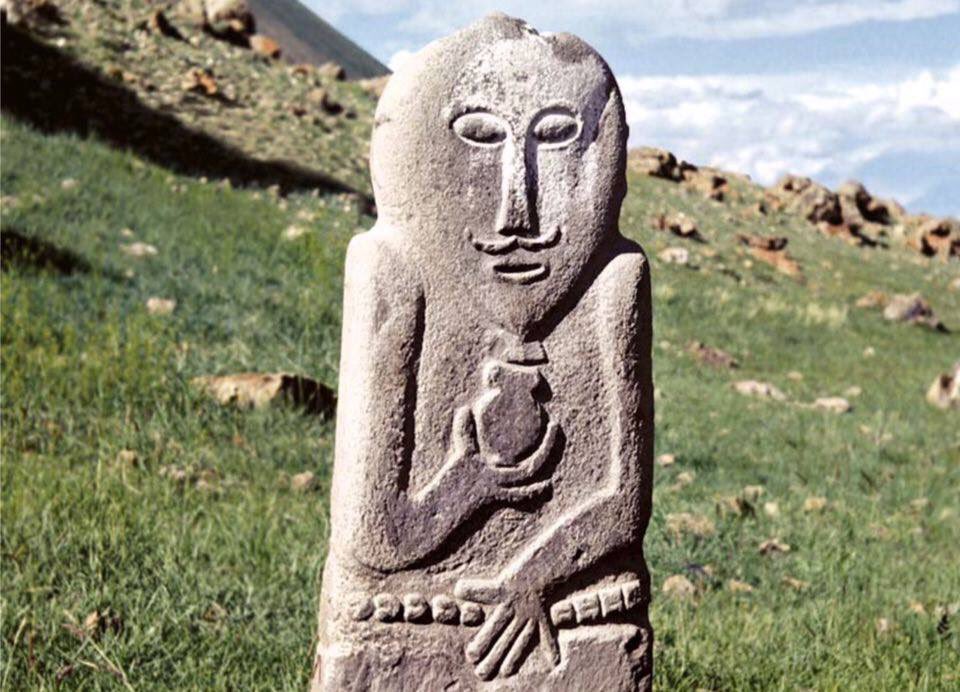TRIZNA AND STONE SCULPTURES (tradition divided)
DOI:
https://doi.org/10.52967/akz2021.1.11.101.119Keywords:
archaeology, trizna, commemoration, farewell, hearth, statues, altar, sacrificial horse, horse racing, ethnographyAbstract
The article comprehensively examines and substantiates the idea that the Kazakh tradition of triznas (as beru) and the installation of stone statues in the early period were one ritual action. This is indicated by the fact that the places where the stone statues
were installed coincide with the places where the funeral triznas of the last centuries were held. People’s memory of these places is still associated with commemoration, and calls the honor of the deceased – “the hearth of such” (e.g.: “the hearth of Ormanbet”, “the hearth of Bektas”, etc.). The hearth is the place where during the commemoration “field” kitchens were arranged, the cattle allocated for slaughter were slaughtered there, and kazans were set up, and meat was continuously cooked for the guests. The article also contains the results of expeditionary studies of the relevant places; summarized the traditions and ancient rituals that accompanied the funeral feast; elements of stone statues with the image of dishes and utensils were considered, testifying to their connection with the ancient tradition of triznas, and their semantic meaning is revealed.
References
Aqjoltay Agybay batur (Lucky Agybai batyr). 1992. Jezkazgan: Obltipografiya (in Kazakh).
Amanbayev, Z. 2001. Äwlet araliq estelik. Estelik-şejire (Genealogy memo). 1-bölim. Balqaş: Qalalyq baspaxana (in Kazakh).
Abishev, H. 1962. Aspan siri (Mystery sky). Almaty: Kazakh mem-tik sayasy baspasy (in Kazakh).
Bronevskiy, S. B. 1830. In: Otechestvennyye zapiski (Domestic notes), 43, no. 124, 119–356 (in Russian).
Walikhanov, Sh. 1985. In: Sobraniye sochineniy: v pyati tomakh (Collected works in five volumes). Vol. 5. Alma-Ata: Glavnaya Red. Kaz. Sovet. Entsiklopedii (in Russian).
Venyukov, M. I. 1868. Puteshestviye po okrainam russkoy Azii i zapiski o nikh (Travel to the outskirts of Russian Asia and notes about them). Saint Petersburg: Tipografiya Imperatorskoy Akademii nauk (in Russian).
Grach, A. D. 1961. Drevnetyurkskiye izvayaniya Tuvy (Turkic sculptures of Tuva). Moscow: Izd-vo vost. lit-ry (in Russian).
Dnevnyye zapiski puteshestviya kapitana N. Rychkova v Kirgis-kaysatskoy stepi 1771 godu (Day notes of the voyage of captain N. Rychkov in the Kirgis-Kaisak steppe in 1771). 1772. Saint Petersburg: Tipografiya Imperatorskoy Akademii nauk (in Russian).
Dosymbayeva, A. 2006. Zapadnyy Tyurkskiy kaganat. Kulturnoye naslediye kazakhskikh stepey (Western Turkic Kaganate. Cultural heritage of the Kazakh steppes). Almaty: “Kompleks” Publ. (in Russian).
Yermolenko, L. N. 2004. Srednevekovyye kamennyye izvayaniya Kazakhstanskikh stepey (Middle-century stone sculptures of Kazakhstan steppes). Novosibirsk: Archeology and ethnography Institute SB RAS (in Russian).
Zeland, L. N. 1885. In: Zapiskiy zapadno-sibirskogo otdela Russ. Geogr. Obshch (Zapiskiy of the West Siberian Department of Russ. Geogr. Society), 7, 2, 1–78 (in Russian).
Kastaniye, I. A. 1910. In: Trudy Orenburgskoy Uchenoy Arkhivnoy Komissii (Proceedings of the Orenburg Scientific Archival Commission), 22 (in Russian).
Kastaniye, I. A. 1911. In: Trudy Orenburgskoy Uchenoy Arkhivnoy Komissii (Proceedings of the Orenburg Scientific Archival Commission), 26 (in Russian).
Kirgiz-kaysaki Bolshoy, Sredney i Maloy ordy po zapisyam Andreyeva, s dopolneniyami P.K. Frolova i izdatelya (Kirghiz-kaisaks of the Great, Middle and Small Horde according to Andreev’s notes, with additions by P.K. Frolov and the publisher). 1820 / Sibirskiy vestnik, IX-XI (in Russian).
Konur-Auliye. 1892. In: Vitebskaya Gubernskaya Vedomosti (Vitebsk Provincial Gazette), no. 63 (in Russian).
Kyzlasov, L. R. 1964. In: Sovetskaya arkheologiya (Soviet archeology), 2, 27–39 (in Russian).
Kurmankulov, J., Ermolenko, L. 2014. Ejelgi Saryarqa tas müsinder (Ancient Saryarka stone sculptures). Karagandy: “Credos Ltd C” (in Kazakh, Russian, English).
Levshin, A. I. 1832. Opisaniye kirgiz-kazachiikh, ili kirgiz-kaysatskikh ord i stepey (Description of Kirghiz-Cossack or Kirghiz-kaisak Orda). Ch. 3: Etnograficheskiye izvestiya, Saint Petersburg: “Karl Kray” Publ. (in Russian).
Manas: Velikiy pokhod. Kyrgyzskiy epos (Manas: the Great campaign. Kyrgyz epic). 2004. / Per. S. Lipkina i dr. Bishkek: “Sham” (in Russian).
Margulan, A. X. 1985. Ejelgi jyr, anyzdar: gylymi-zertteu makalalar (Ancient poems, legends: Research articles). Almaty: “Jazushi” (in Kazakh).
Margulan, A. 2007. In: A.X. Margulan shygarmalary. Almaty: “Alatau”, vol. IV, 221–274 (in Kazakh).
Narody Rossii. Kirgizy: [etnograficheskiye ocherki] (People of Russia. Kirghiz: ethnographic essays). 1880. Saint Peterburg: “Dosug i delo” Publ. (in Russian).
Radlov, V. V. 1989. Iz Sibiri. Stranitsy dnevnika (From Siberia. Diary pages) / Per. s nem. K.D. Tsivinoy, V.Ye. Chistovoy. Prim. i posles. S.I. Vaynshteyna. Moscow: “Nauka” Publ. (in Russian).
Rudenko, S. I. 1953. Kultura naseleniya Gornogo Altaya v skifskoye vremya (Culture of the population of the Altay Mountains in the Scythian period). Moscow–Leningrad: Izd-vo AN SSSR (in Russian).
Smagulov, E. M. 2005. Kazakhtyn as beru dasturi: kogamdik-aleumettik kyzmeti (Trizna-Kazakh tradition):thesis Cand. hist. sciences. Almaty (in Kazakh).
Tursyn Jurtbay. URL: https: // abaialemi.kz /post/ view?id=910 (in Kazakh).
Halid Kurbangali. 1992. Tauarih hamsa: Bes tarih (Tauarikh hamsa: Five stories) / awd. B. Totenayev, A. Joldasov. Almaty: “Kazakhstan” (in Kazakh).
Chormanov, M. 2000. Kazakhskiye narodnyye obychai (Kazakh folk customs). Karaganda: “Arko” Publ. (in Russian).
Sharipov, S. 1982. Baganaly elinin jayi (The situation in the country of Baganaly) / Shygarmalar jinagy. II t. Almaty: “Jazushi” (in Kazakh).
Sher, Ya. A. 1966. Kamennyye izvayaniya Semirechiya (Stone sculptures of Semirechye). Moscow–Leningrad: “Nauka” Publ. (in Russian).
Shombal-Kukashev, R. 2001. In: Kazakhtyn adet-guriptari men salt-dasturleri: otkendegisi jane bugini (Kazakh customs and traditions: past and present). Almaty: “Gylym” Publ., 351–373 (in Russian, Kazakh).

Downloads
Published
How to Cite
Issue
Section
License
Copyright (c) 2021 Orynbay Zh. Oshanov

This work is licensed under a Creative Commons Attribution-NonCommercial 4.0 International License.






